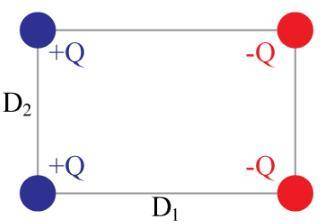
Physics, 15.02.2021 19:30 ksawyer745
Four point charges of equal magnitude Q = 75 nC are placed on the corners of a rectangle of sides D1 = 18 cm and D2 = 6 cm. The charges on the left side of the rectangle are positive while the charges on the right side of the rectangle are negative. Use a coordinate system where the positive y direction is up and the positive x direction is to the right.
(b) Calculate the horizontal component of the net force, in newtons, on the charge which lies at the lower left corner of the rectangle.
Fx = 2.893E-3
(c) Calculate the vertical component of the net force, in newtons, on the charge which lies at the lower left corner of the rectangle.
(d) Calculate the magnitude of the net force, in newtons, on the charge located at the lower left corner of the rectangle.
(e) Calculate the angle of the net force vector relative to the +x axis, with the positive direction being counterclockwise from the positive horizontal axis. Enter an angle between -180° and 180°.


Answers: 3


Another question on Physics

Physics, 21.06.2019 23:30
In order for the bug to fly through the air a force has to push the bug forward. identify this force. how does the bug produce
Answers: 1

Physics, 22.06.2019 07:20
Aman throws a football straight into the air. as it rises, it slows down. which type of energy is the football gaining?
Answers: 2

Physics, 22.06.2019 15:40
Question 1 what is amperage? is the rate of doing work. is the rate of flow of protons in electric current. represents the amount of pressure behind electron flow. is the rate of flow of electrons in electric current. 2 points question 2 what is voltage? is the rate of doing power. represents the amount of pressure behind electron flow. is the rate of doing work. is the rate of flow of electrons in electric current. 2 points question 3 what is power? is the rate of flow of protons in electric current. is the rate of flow of electrons in electric current. is the rate of doing work. represents the amount of pressure behind electron flow. 2 points question 4 if we multiply volts times amps we get what? power circuit work current 2 points question 5 what are two ways alternating currents are similiar? in both ac and dc electrons flow in the same pattern. in both ac and dc, the flow of electrons changes directions back and forth. both ac and dc are only possible in certain materials with atoms that will allow electron flow. both ac and dc involve the flow of electrons. 4 points question 6 how does the flow of electrons flow in an alternating current? the flow of electrons is always slower in an alternating current than within a direct current. the flow of electrons is not constant and forward; it changes direction back and forth. electrons flow from from a higher affinity to that of a lower affinity. electron flow is constant and only in a forward direction. 2 points question 7 what is the flow like in a direct current? the flow of electrons is not constant and forward; it changes direction back and forth. the flow of electrons is constant and only in a forward direction. the flow of electrons go from a higher affinity to a lower affinity. the flow of electrons are always faster in a direct current. 2 points question 8 how is an electric current able to flow? electrons flow from the higher affinity to lower affinity and electrical current is generated. protons flow from the higher affinity to lower affinity and electrical current is generated. the movement of protons from one atom to another leads to an electric charge. the movement of electrons from one atom to another atom in a line results in a flow of electric current. 2 points question 9 how do electrons move from the two different types of metal in a battery? protons flow from the metal with the lower affinity to the metal with higher affinity and electrical current is generated. electrons flow from the metal with the lower affinity to the metal with higher affinity and electrical current is generated. electrons flow from the metal with the higher affinity to the metal with lower affinity and electrical current is generated. protons flow from the metal with the higher affinity to the metal with lower affinity and electrical current is generated.
Answers: 2

Physics, 22.06.2019 17:30
Convection currents are caused by differences in what two things?
Answers: 1
You know the right answer?
Four point charges of equal magnitude Q = 75 nC are placed on the corners of a rectangle of sides D1...
Questions

History, 22.06.2019 07:40



Health, 22.06.2019 07:40









English, 22.06.2019 07:50

History, 22.06.2019 07:50




History, 22.06.2019 07:50





